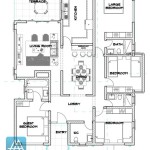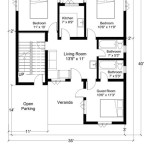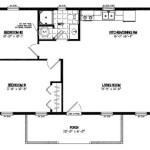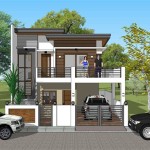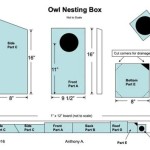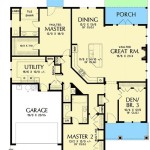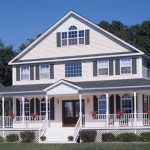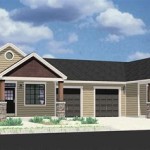Floor Plans For 4 Bedroom One Story House
Designing a four-bedroom, single-story house presents a unique opportunity to create a functional and comfortable living space. The absence of stairs makes this layout exceptionally appealing for families with young children, individuals with mobility challenges, and those seeking a long-term residence that accommodates changing needs. Careful consideration must be given to the organization of space, ensuring optimal flow, privacy, and accessibility.
Developing a floor plan requires a detailed understanding of the occupants' lifestyle, preferences, and future requirements. This includes evaluating the desired size of each room, the need for dedicated spaces like home offices or playrooms, and the importance of natural light and outdoor access. A well-designed four-bedroom, one-story house can maximize space utilization, promote harmonious living, and enhance overall quality of life.
Key Considerations in Designing a 4-Bedroom One-Story Home
Several key factors need to be carefully considered when planning the layout of a four-bedroom, one-story home. These considerations involve everything from optimizing space utilization to ensuring accessibility and accommodating future changes. The following points are crucial for designing a well-functioning and comfortable living environment.
Optimizing Space and Layout
Efficient space utilization is paramount in a single-story home. Maximizing usable square footage while maintaining a comfortable flow between rooms necessitates careful planning. Open-concept designs, which combine living, dining, and kitchen areas, can create a sense of spaciousness and facilitate social interaction. However, it’s important to delineate these areas visually and functionally through strategic furniture placement, varying floor coverings, or partial walls.
The arrangement of bedrooms is also crucial. Ideally, the master bedroom should be situated away from the other bedrooms to provide privacy. Considering the orientation of the house on the lot is essential, ensuring the living areas and bedrooms receive ample natural light. Strategic placement of windows and doors can also contribute to energy efficiency by maximizing solar gain in the winter and minimizing it in the summer.
Hallways should be kept as short and wide as possible to minimize wasted space and improve accessibility. Pocket doors or sliding doors can be used in areas where space is limited, such as bathrooms or closets. Built-in storage solutions, such as bookshelves or window seats with storage underneath, can further maximize space utilization.
Furthermore, consider the placement of utilities, such as the laundry room and HVAC systems. These should be located in areas that minimize noise disruption to living spaces and are easily accessible for maintenance. A well-planned layout will minimize unnecessary travel distances between rooms and create a seamless flow throughout the house.
Privacy and Zoning
Creating distinct zones within the house is important for maintaining privacy and functionality. Bedrooms, especially the master suite, should be located in a separate zone from the main living area. This separation can be achieved through hallways, buffer zones like bathrooms or closets, or changes in elevation, although elevation changes can be difficult in a single-story home and may compromise accessibility.
The kitchen, often the heart of the home, should be positioned near the dining area and possibly integrated with the living room to facilitate interaction during meal preparation and social gatherings. However, a well-placed island or peninsula can provide a visual barrier and help to contain kitchen activities.
Bathrooms should be conveniently located near bedrooms and living areas, but also positioned to minimize noise and odors. Consider adding a powder room near the entrance for guests. The use of soundproofing materials in walls and floors can further enhance privacy and reduce noise transmission between rooms.
The placement of the garage and any outdoor living spaces should also be carefully considered in relation to privacy. A strategically placed fence or landscaping can create a private backyard oasis, shielding it from street noise and prying eyes. Similarly, the garage should be positioned to minimize noise and fumes entering the house.
Accessibility and Universal Design Principles
Incorporating accessibility features into the floor plan is essential for creating a home that can be enjoyed by people of all ages and abilities. This is particularly important in a single-story house, where the absence of stairs makes it naturally more accessible. However, other design elements must also be considered to ensure ease of use for everyone.
Wide doorways (at least 36 inches wide) and hallways (at least 42 inches wide) are crucial for accommodating wheelchairs and walkers. Ramps should be provided at entrances with slopes that meet accessibility standards. Lever-style door handles and rocker-style light switches are easier to operate than traditional knobs and switches.
Bathrooms should be designed with ample maneuvering space and include features such as grab bars, adjustable-height showerheads, and comfort-height toilets. A roll-in shower eliminates the need to step over a tub wall, making it easier for individuals with mobility limitations to bathe. Kitchens should incorporate adjustable-height countertops and appliances with front-mounted controls.
Consider incorporating a zero-step entry from the garage into the house. This eliminates the need for ramps or steps, making it easier to carry groceries or transport mobility devices. By incorporating these and other accessibility features, the house can be made more comfortable and convenient for all occupants, regardless of their abilities.
Common 4-Bedroom One-Story Floor Plan Layouts
Several established layouts cater to the needs of a four-bedroom, single-story home. Each layout offers distinct advantages in terms of space utilization, privacy, and functionality. Understanding these common layouts provides a foundation for customizing a floor plan to suit specific requirements.
Ranch Style
The ranch-style floor plan is characterized by its horizontal layout and sprawling footprint. Typically, bedrooms are located on one side of the house, while the living areas are located on the other. This separation of spaces provides a degree of privacy between sleeping and living areas. Ranch-style homes often feature large windows and sliding glass doors, connecting the interior to the outdoors.
In a four-bedroom ranch, the master suite is often positioned at one end of the bedroom wing, providing a private retreat for the homeowners. The remaining three bedrooms are typically located closer to each other, sharing a bathroom or possibly having a jack-and-jill bathroom for two of the bedrooms. The central living area typically comprises a large living room, a dining area, and a kitchen that may be open to the living room or separated by a breakfast bar or island.
A garage is usually attached to the house, often accessed from the kitchen or laundry room. The ranch-style layout is well-suited for larger lots, as it requires a significant amount of lateral space. It also offers excellent accessibility due to its single-story design.
Split Bedroom Plan
The split bedroom plan strategically divides the bedrooms into separate zones. Typically, the master suite is located on one side of the house, while the remaining bedrooms are located on the opposite side. This arrangement provides maximum privacy for the master suite, making it ideal for families with teenagers or for those who frequently entertain guests.
In a four-bedroom split plan, the master suite typically includes a private bathroom and walk-in closet. The remaining three bedrooms may share a bathroom or have separate bathrooms, depending on the size of the house. The living areas, including the living room, dining area, and kitchen, are usually located in the center of the house, serving as a buffer between the bedroom zones.
This layout is particularly well-suited for families who value privacy and separation of spaces. It also works well for multi-generational households, where different family members may have different schedules and needs. The split bedroom plan can be adapted to various architectural styles and offers a flexible layout that can be customized to suit specific preferences.
Open Concept with Central Living Area
The open concept with central living area layout prioritizes a spacious and fluid living space. The living room, dining area, and kitchen are typically combined into a single, large room, creating a sense of openness and promoting social interaction. The bedrooms are located around the perimeter of the central living area, providing a degree of separation while still being easily accessible.
In a four-bedroom open concept plan, the master suite is often located at one end of the house, while the remaining three bedrooms are clustered together on the other end. The central living area serves as the focal point of the house, providing a space for family gatherings, entertaining guests, and everyday activities. This layout is particularly well-suited for families who enjoy spending time together and prefer a more casual and informal living environment.
The open concept design can maximize natural light and ventilation, creating a bright and airy atmosphere. However, it's important to consider noise levels and privacy when designing an open concept plan. Strategically placed furniture, area rugs, and soundproofing materials can help to mitigate noise and create distinct zones within the larger space.
Factors Influencing Floor Plan Choices
The selection of a specific floor plan is influenced by a variety of factors, encompassing lifestyle preferences, lot characteristics, budgetary considerations, and regional building codes. A thorough assessment of these intertwined elements is crucial for making an informed decision and tailoring a floor plan that aligns seamlessly with both the occupants' needs and the physical constraints of the building site.
Lifestyle and Needs
The occupants' lifestyle and individual needs significantly shape the ideal floor plan. A family with young children may prioritize a large, open living area for playtime and supervision. Empty nesters might prefer a smaller, more manageable layout with an emphasis on low-maintenance design.
Individuals who work from home require a dedicated office space, preferably located away from the main living areas to minimize distractions. Those who enjoy entertaining may prioritize a large kitchen and dining area, along with an outdoor living space for gatherings. Additionally, hobbies and recreational activities should be considered when allocating space for storage and specialized rooms.
Understanding the daily routines, habits, and preferences of the occupants is essential for creating a floor plan that supports their lifestyle and enhances their quality of life. This involves considering factors such as the number of occupants, their ages, their interests, and their work styles. A well-designed floor plan should adapt to the occupants' needs and provide a comfortable and functional living environment for years to come.
Lot Size and Orientation
The size and orientation of the building lot play a crucial role in determining the optimal floor plan. A small lot may necessitate a compact and efficient layout that maximizes usable space. A larger lot offers greater flexibility in terms of design and allows for more sprawling layouts.
The orientation of the lot dictates the amount of sunlight that the house receives throughout the day. Southern exposure typically provides the most sunlight, while northern exposure may result in cooler and darker interiors. The floor plan should be designed to take advantage of the natural light and warmth of the sun, while also minimizing glare and overheating. The placement of windows and doors should be carefully considered to maximize natural light and ventilation.
Site conditions, such as topography, soil type, and drainage, can also influence the floor plan. A sloping lot may require a split-level design or extensive excavation. Poor soil conditions may necessitate special foundation requirements. The floor plan should be designed to accommodate the site conditions and minimize the need for costly modifications.
Budgetary Constraints
Budgetary constraints are a significant factor in determining the feasibility and scope of a floor plan. The size of the house, the complexity of the design, and the quality of the materials all affect the overall cost. It is essential to establish a realistic budget early in the planning process and to prioritize the most important features.
Simple and efficient floor plans are typically less expensive to build than complex and elaborate designs. Reducing the footprint of the house, streamlining the layout, and using standard building materials can help to control costs. It is also important to consider the long-term costs of ownership, such as energy consumption and maintenance. Energy-efficient designs and durable materials can help to reduce these costs over time.
A cost-benefit analysis should be performed to evaluate the trade-offs between different design options. For example, adding a second bathroom may increase the initial cost of the house, but it can also improve its resale value and enhance its functionality. The floor plan should be designed to maximize value and minimize costs, while still meeting the occupants' needs and preferences.

Four Bedroom Single Y House Plans Google Search Story Floor 5 Barndominium

1 Story 4 Bedroom In 2024 Floor Plans House

Must Have One Story Open Floor Plans Blog Eplans Com

Four Bedroom One Story House Plan 82055ka Architectural Designs Plans

European Style House Plan 4 Beds 3 Baths 2453 Sq Ft 929 Floor Plans How To Open

Single Story 4 Bedroom Traditional House With Bonus And Flex Room Plan
.jpg?strip=all)
Single Story Home Plan With Four Bedrooms 4474

Stylish One Story House Plans Blog Eplans Com

4 Bedroom Apartment House Plans

One Story 4 Bedroom House Plans
Related Posts

